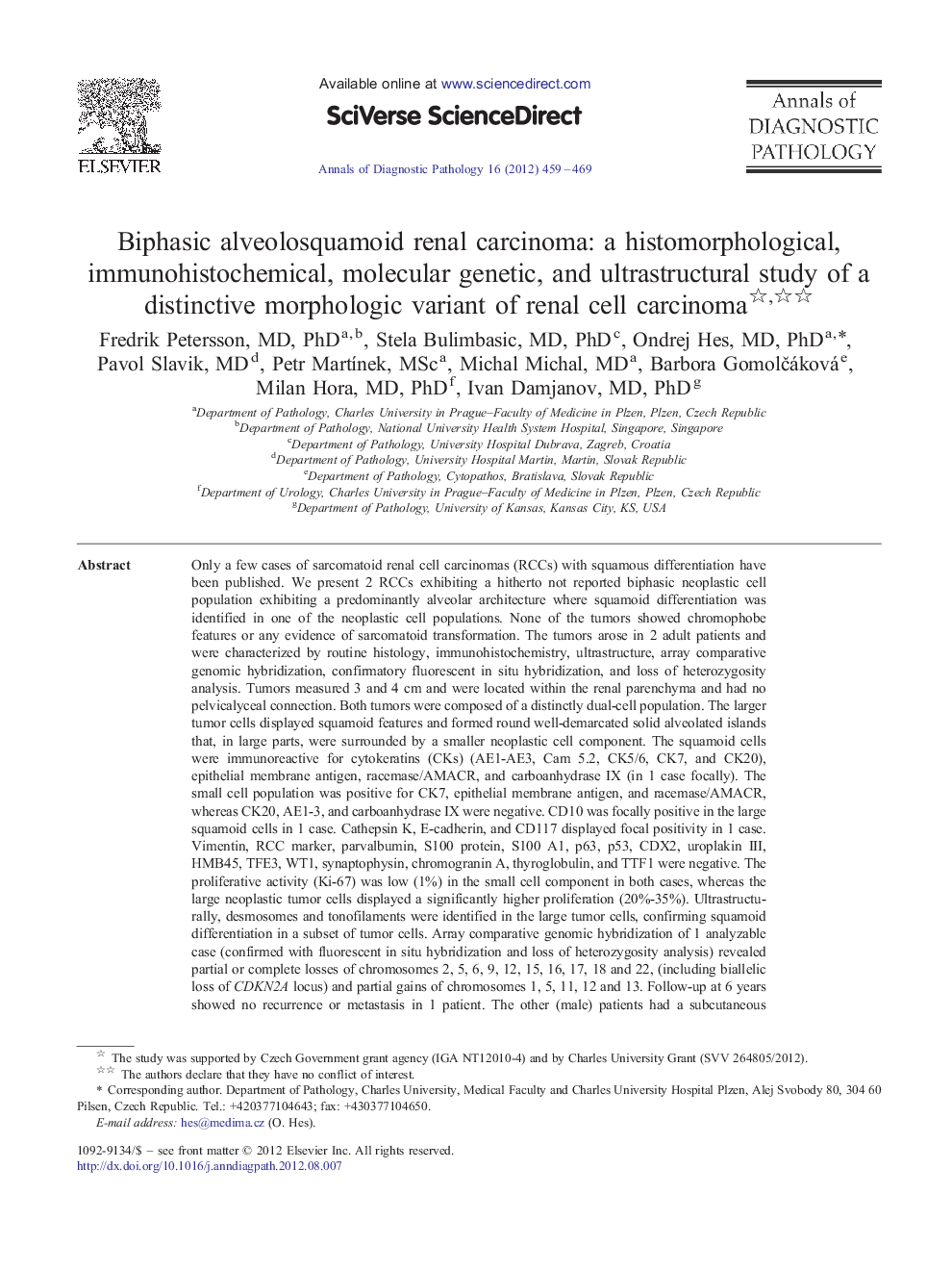| کد مقاله | کد نشریه | سال انتشار | مقاله انگلیسی | نسخه تمام متن |
|---|---|---|---|---|
| 6215106 | 1606494 | 2012 | 11 صفحه PDF | دانلود رایگان |

Only a few cases of sarcomatoid renal cell carcinomas (RCCs) with squamous differentiation have been published. We present 2 RCCs exhibiting a hitherto not reported biphasic neoplastic cell population exhibiting a predominantly alveolar architecture where squamoid differentiation was identified in one of the neoplastic cell populations. None of the tumors showed chromophobe features or any evidence of sarcomatoid transformation. The tumors arose in 2 adult patients and were characterized by routine histology, immunohistochemistry, ultrastructure, array comparative genomic hybridization, confirmatory fluorescent in situ hybridization, and loss of heterozygosity analysis. Tumors measured 3 and 4 cm and were located within the renal parenchyma and had no pelvicalyceal connection. Both tumors were composed of a distinctly dual-cell population. The larger tumor cells displayed squamoid features and formed round well-demarcated solid alveolated islands that, in large parts, were surrounded by a smaller neoplastic cell component. The squamoid cells were immunoreactive for cytokeratins (CKs) (AE1-AE3, Cam 5.2, CK5/6, CK7, and CK20), epithelial membrane antigen, racemase/AMACR, and carboanhydrase IX (in 1 case focally). The small cell population was positive for CK7, epithelial membrane antigen, and racemase/AMACR, whereas CK20, AE1-3, and carboanhydrase IX were negative. CD10 was focally positive in the large squamoid cells in 1 case. Cathepsin K, E-cadherin, and CD117 displayed focal positivity in 1 case. Vimentin, RCC marker, parvalbumin, S100 protein, S100 A1, p63, p53, CDX2, uroplakin III, HMB45, TFE3, WT1, synaptophysin, chromogranin A, thyroglobulin, and TTF1 were negative. The proliferative activity (Ki-67) was low (1%) in the small cell component in both cases, whereas the large neoplastic tumor cells displayed a significantly higher proliferation (20%-35%). Ultrastructurally, desmosomes and tonofilaments were identified in the large tumor cells, confirming squamoid differentiation in a subset of tumor cells. Array comparative genomic hybridization of 1 analyzable case (confirmed with fluorescent in situ hybridization and loss of heterozygosity analysis) revealed partial or complete losses of chromosomes 2, 5, 6, 9, 12, 15, 16, 17, 18 and 22, (including biallelic loss of CDKN2A locus) and partial gains of chromosomes 1, 5, 11, 12 and 13. Follow-up at 6 years showed no recurrence or metastasis in 1 patient. The other (male) patients had a subcutaneous metastasis at presentation, but during a 1-year follow-up no evidence of recurrence or further metastatic events have been documented. Our data indicate that biphasic alveolosquamoid renal carcinoma is a unique and distinctive tumor. The large squamoid and small tumor cells have overlapping but still distinctive immunohistochemical patterns of protein expression. Multiple chromosomal aberrations were identified, some of them located in regions with known tumor suppressor genes and oncogenes.
Journal: Annals of Diagnostic Pathology - Volume 16, Issue 6, December 2012, Pages 459-469